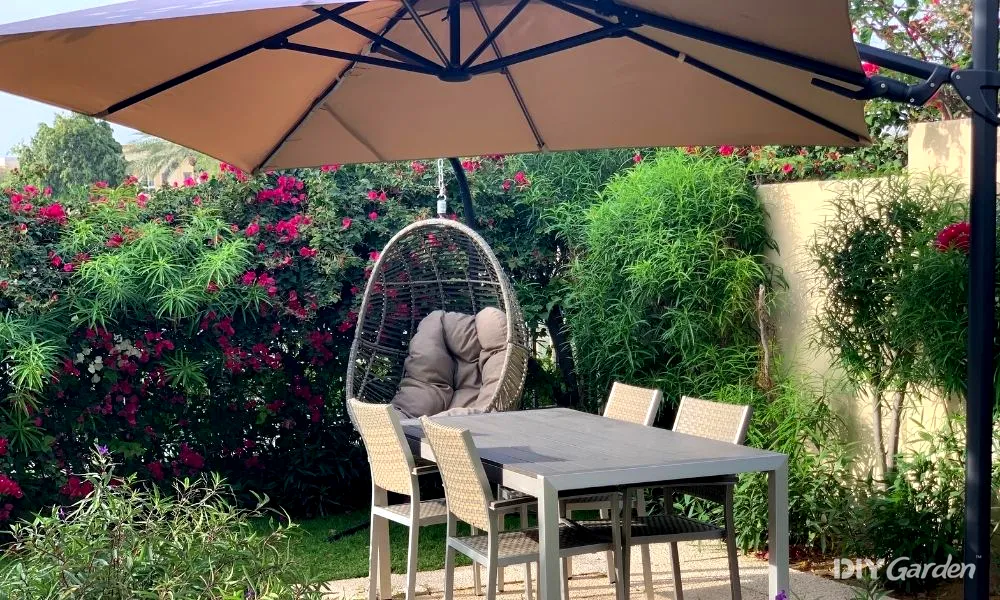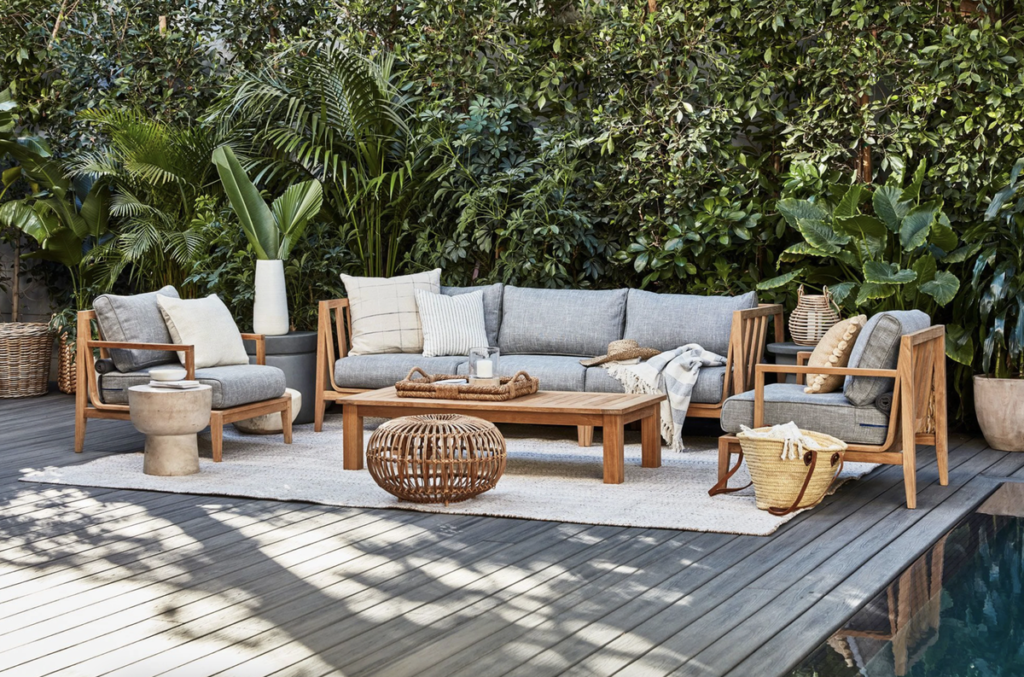What is a Patio Umbrella?
A patio umbrella is a type of outdoor umbrella used for shading outdoor spaces like patios, decks, gardens, and terraces from the sun’s heat and UV rays. It’s a popular addition to outdoor furniture sets, providing comfort, style, and protection from the elements.
Patio umbrellas come in a variety of sizes, shapes, and styles, from traditional round models to cantilever umbrellas. They can also be made with different materials such as aluminum, wood, fiberglass, or steel, each providing its unique benefits like durability or flexibility.
The canopy sizes are also a crucial factor when choosing a patio umbrella as they can range in different diameters from 6 to 12 feet or more. Larger umbrellas are ideal for bigger patio tables or sitting areas that require more shade coverage.
Patio umbrellas also come in different colors and patterns, allowing them to complement the outdoor furniture and decor. Additionally, some models feature adjustable canopies that can be tilted to different angles to provide better shade coverage throughout the day, depending on the sun’s position.
A patio umbrella is not only functional but also adds an aesthetic appeal to the outdoor space. It can create a cozy, inviting atmosphere for outdoor entertainment, dining, or relaxation. Regardless of the patio umbrella model and design you choose, it’s essential to secure the umbrella base to prevent it from being blown away by strong winds, which can cause damage or even pose a danger to nearby people or property.
Overall, a patio umbrella is an essential accessory for any outdoor space, providing not only protection and comfort but also enhancing its aesthetics.
The Problem with Wind and Patio Umbrellas
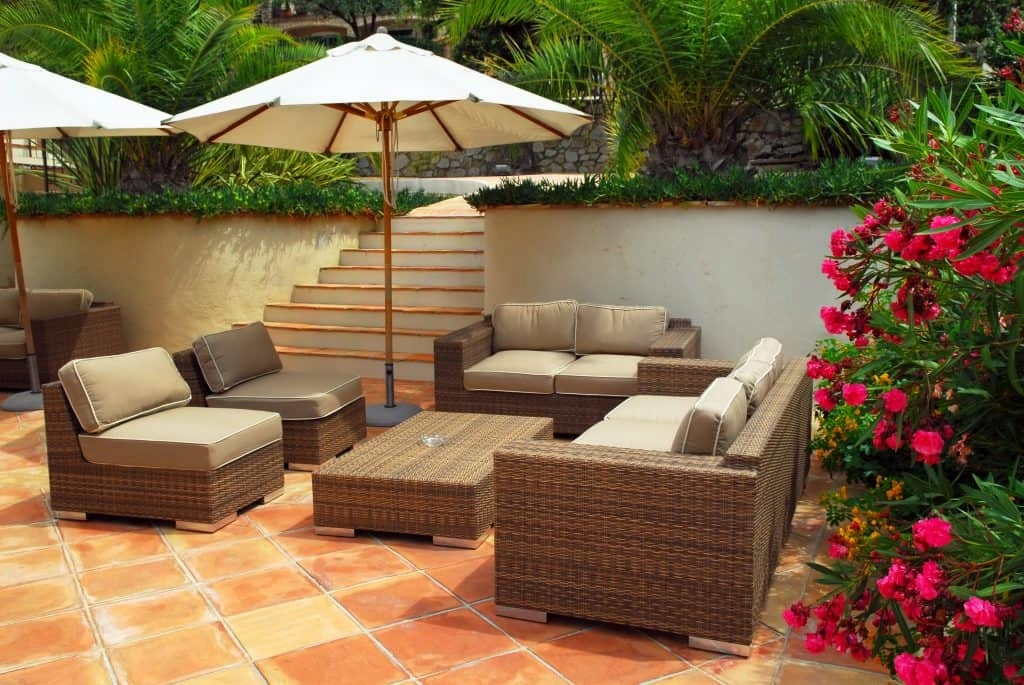
Best Patio umbrellas are a must-have accessory for anyone who loves spending time outdoors. They provide much-needed shade, shield from the sun’s harmful UV rays, and add a decorative touch to your outdoor space. However, as much as we love them, there is one big problem that comes with owning a patio umbrella – wind.
Strong gusts of wind can quickly turn your beloved patio umbrella into a dangerous weapon. If not adequately secured, your umbrella can be lifted out of its base and get lost in the wind. Worse yet, it can tip over and cause significant damage to your outdoor furniture, nearby property, or even people. This is why it’s crucial to take the proper measures to ensure that your patio umbrella stays put, even in the strongest of winds.
One solution to the problem of wind and patio umbrellas is to invest in a heavier base or a weighted base. Generally, the heavier the base, the sturdier the umbrella will be. This added weight provides more stability and makes it harder for wind gusts to lift the umbrella off its base. You can also add weight bags or water with sand to further anchor the base and make it even more challenging to move.
Additionally, using a bungee cord or weights to attach the umbrella securely to the patio table or chair it’s holding up can help keep it in place. If you have a cantilever umbrella, make sure the base is strong and sturdy enough to hold the entire structure.
For those who love the beach and pool, consider investing in beach umbrella anchors or a pool umbrella that features a heavier and more secure base.
Ultimately, when it comes to wind and patio umbrellas, it’s all about common sense. Always close the umbrella when not in use, especially during inclement weather. If there are frequent gusts of wind in your area, it may be worth looking into an umbrella with a wider or heavier base.
In conclusion, while patio umbrellas are a wonderful addition to any outdoor space, it’s crucial to take the necessary steps to ensure they remain grounded. With the right base, weights, and proper use, you can enjoy your patio umbrella without worrying about it becoming a dangerous weapon in strong winds.
Types of Umbrellas to Consider

When it comes to choosing an umbrella, there are many different types to consider. From small portable umbrellas to large patio umbrellas, each one serves a unique purpose and comes with its own set of features. Here are some of the most common types of umbrellas to consider:
1. Compact Umbrellas: These small, lightweight umbrellas are ideal for carrying around in your bag or purse. They typically have a simple design and fold up into a compact shape for easy storage. Compact umbrellas are perfect for commuting or traveling, as they can easily be stashed away when not in use.
2. Golf Umbrellas: As the name suggests, these umbrellas are designed for use on the golf course. They are typically larger than standard umbrellas, with a wider canopy and longer handle. Golf umbrellas are great for providing shade and protection during outdoor sporting events or activities.
3. Patio Umbrellas: These large, sturdy umbrellas are designed to provide shade on your patio or outdoor living space. They typically have a wide canopy and are supported by a heavy base or stand. Patio umbrellas come in a variety of colors and styles, making them a popular choice for outdoor entertaining.
4. Beach Umbrellas: Similar to patio umbrellas, beach umbrellas are designed to provide shade at the beach or pool. They typically have a pointed bottom that can be inserted into the sand, as well as a wide canopy to block out the sun. Look for beach umbrellas that are made from durable, water-resistant materials to withstand exposure to saltwater and sand.
5. Transparent Umbrellas: These unique umbrellas are constructed with a transparent canopy that allows you to see through them. They are great for providing protection from the rain while still allowing you to see where you’re going. Transparent umbrellas come in a variety of colors, patterns, and styles, making them a fun and fashionable choice for rainy days.
6. LED Umbrellas: For those who love a little extra flair, LED umbrellas are a fun and functional option. These umbrellas come with a built-in LED light system that illuminates the canopy, making them perfect for use at night or in low-light conditions. They are also great for adding a pop of color and style to your outfit.
No matter which type of umbrella you choose, be sure to consider factors such as size, durability, and ease of use. With so many options available, you’re sure to find an umbrella that fits your needs and style preferences.
Cantilever Umbrellas
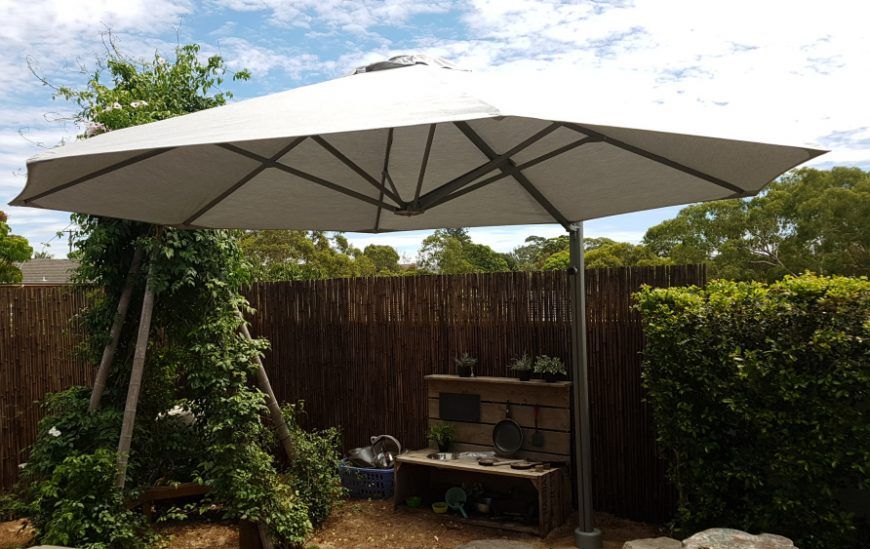
Cantilever umbrellas are a popular choice for those who want to add a touch of style and functionality to their outdoor space. Unlike traditional patio umbrellas, cantilever umbrellas are supported by a sturdy base rather than a center pole. This design allows for more flexibility in the placement of the umbrella and can provide a larger coverage area.
One of the biggest advantages of cantilever umbrellas is their ability to rotate 360 degrees. This means that you can easily adjust the umbrella to provide shade no matter where the sun is in the sky. Additionally, some cantilever umbrellas come with tilt features, allowing you to adjust the angle of the canopy for even more precise shading.
Cantilever umbrellas are also popular for their ease of use. Many models come with a crank system that allows you to easily open and close the umbrella with minimal effort. Some even have push-button mechanisms or remote controls, making them even more convenient to use.
When it comes to size, cantilever umbrellas can range from small to quite large. While larger umbrellas can provide more shade coverage, they also require a more substantial base to support them. It’s important to check the weight capacity of the base that comes with the umbrella or to invest in a separate base if needed.
Another consideration with cantilever umbrellas is their construction materials. Look for models that are made with durable materials, such as aluminum or steel frames and water-resistant canopies. This will ensure that the umbrella can withstand frequent use and exposure to the elements.
Overall, cantilever umbrellas are a stylish and practical addition to any outdoor space. Their flexibility, ease of use, and large coverage area make them a popular choice for anyone looking to enhance their outdoor living experience.
Beach Umbrellas
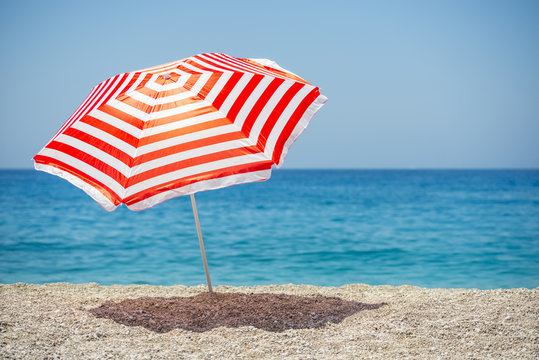
Beach umbrellas are an essential item for any beach-goer trying to escape the harsh rays of the sun. Not only do they provide shade and protection from the sun, but they also add a touch of style to any beach setup.
When looking for a beach umbrella, consider the size and weight. A larger umbrella means more coverage, but it also means more weight to carry. Be sure to check the weight of the umbrella before purchasing and consider investing in a carrying case with a shoulder strap for convenience.
One common issue with beach umbrellas is their tendency to blow away in strong winds. To prevent this, look for beach umbrellas with a sturdy base or those that come with a built-in anchor tool. Another option is using sandbags or water-filled weights to keep the umbrella firmly in place.
When it comes to style, there are many options available. Some beach umbrellas are designed with playful patterns or colors, while others feature more neutral designs. Cantilever umbrellas are also popular for beach use, as they provide more flexibility in adjusting the shade angle.
Overall, a beach umbrella can make or break a relaxing day at the beach. By investing in a quality, sturdy umbrella, you can ensure a comfortable and enjoyable day in the sun.
Larger Umbrellas

If you’re in the market for a patio umbrella, you’re likely well aware of the benefits it can provide. Not only do they provide shade on hot, sunny days, they also add a stylish touch to your outdoor space. But have you considered opting for a larger umbrella? Here’s why it might be worth the investment.
More Coverage, More Comfort
One obvious benefit of a larger umbrella is the increased shade coverage. This means more space for you, your family, and your guests to relax comfortably without having to worry about sunburns. Especially if you have a larger patio table or seating area, a bigger umbrella can make all the difference in ensuring everyone stays cool and comfortable.
Protection from the Elements
In addition to providing shade from the sun, a larger umbrella can also offer protection from other elements. If you live in an area with frequent gusts of wind or sudden bursts of rain, a larger umbrella can help keep your outdoor space dry and protected. Just be sure to choose one with a sturdy base that can properly withstand gusts of wind.
Versatility in Design
With larger umbrellas, there’s also more opportunity to get creative with your design. They come in a variety of styles, colors, and patterns, allowing you to customize your outdoor space to your specific tastes. Whether you’re going for a sleek, modern look or a more rustic feel, there’s a larger umbrella out there that will fit your style.
Investment in Durability
While larger umbrellas may come with a higher price tag, they often make up for it in durability. Because they’re constructed with more material, they’re often built to last longer than their smaller counterparts. And with proper care, a larger umbrella can provide your outdoor space with ample shade and protection for many years to come.
In conclusion, while a larger umbrella may require some extra consideration and investment upfront, it has the potential to greatly enhance your outdoor space. Not only can it offer more shade and protection, it can also add a touch of style and durability that smaller umbrellas may not provide.
Pool Umbrellas
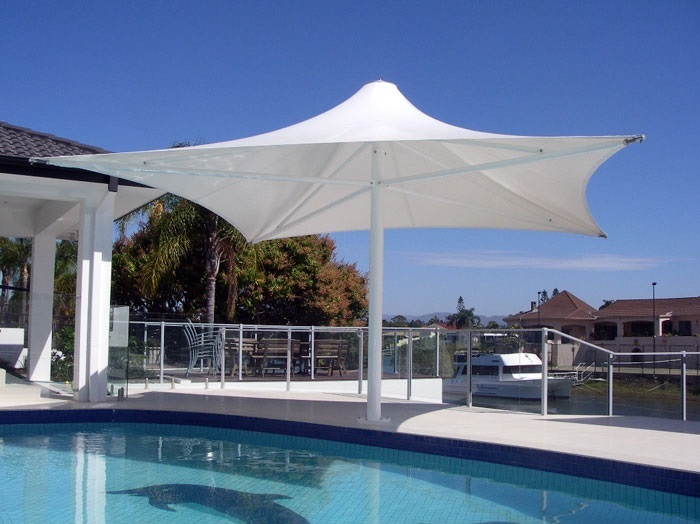
Pool umbrellas are a great addition to any outdoor space, providing shade and style to your poolside area. They offer a range of benefits that make them worth considering for your next outdoor upgrade.
First and foremost, pool umbrellas provide much-needed shade from the sun. UV rays can cause skin damage and increase the risk of skin cancer, so having a reliable source of shade is essential. Pool umbrellas come in a variety of sizes and shapes, from small umbrellas for individual loungers to large umbrellas that cover multiple chairs and tables.
Aside from their practical benefits, pool umbrellas also add a touch of style to your outdoor space. They come in a range of colors and designs, from bold and bright to more neutral and understated. This means you can find a pool umbrella that complements your existing outdoor decor or choose one as a statement piece that sets the tone for your entire space.
When choosing a pool umbrella, it’s important to consider the material. Look for umbrellas made from durable materials that can withstand the elements, including wind, rain, and sun exposure. Aluminum, fiberglass, and wood are popular choices for umbrella frames, while fabrics like polyester and acrylic are common for the canopy material.
It’s also important to choose an umbrella with a sturdy base to keep it in place, especially on windy days. Many pool umbrellas come with weighted bases or the option to add weights, such as sandbags, to keep them anchored down.
Aside from traditional pool umbrellas, cantilever umbrellas have become increasingly popular in recent years. These umbrellas have a large canopy that is attached to a side pole, allowing for more flexible placement and greater coverage. Cantilever umbrellas are ideal for pool areas with irregular shapes or limited space.
In conclusion, pool umbrellas provide both style and practical benefits to your outdoor space. When choosing a pool umbrella, consider the material, size, and design that best suits your needs and tastes. With a reliable source of shade, you can enjoy your poolside area all summer long without having to worry about the sun’s harmful rays.
Steps to Secure Your Patio Umbrella
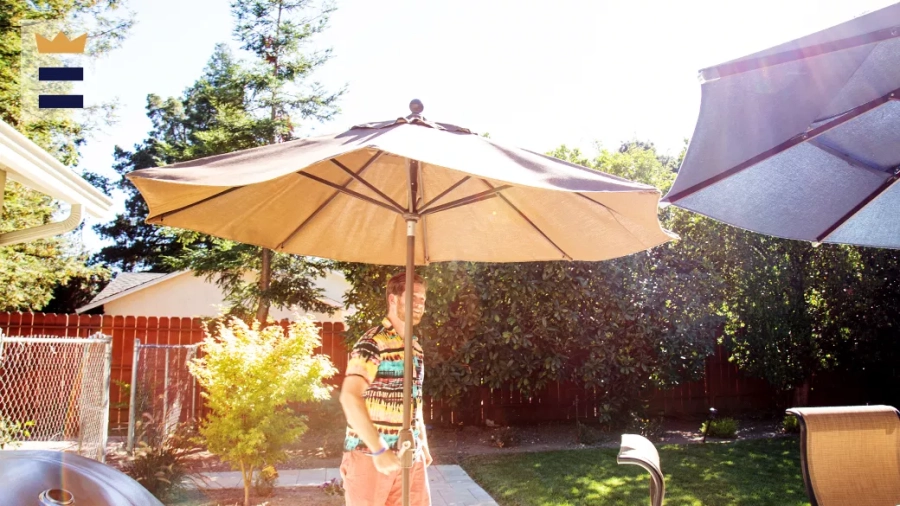
Patio umbrellas are essential for any outdoor space. They provide shade and protection from the sun and can be a stylish addition to your patio or deck. However, if not secured properly, patio umbrellas can quickly become dangerous, especially in strong winds or sudden gusts. To ensure the safety of yourself and your guests and prevent your umbrella from blowing away, follow these steps to secure your patio umbrella.
1. Choose the Right Umbrella Base: One of the most important factors in securing your patio umbrella is selecting the right base. Look for a sturdy base that fits the size of your umbrella and is heavy enough to withstand strong gusts of wind. Some umbrella bases come with a built-in weight or adjustable options so you can add more weight to them. The base can be made of different materials such as metal, plastic or concrete.
2. Add Extra Weight to the Base: If you live in an area with frequent gusts of wind or are dealing with a particularly windy day, add extra weight to the base of your umbrella. You can use sandbags or bricks as weights, or purchase specially designed weights that attach to your umbrella base. This can add a layer of protection to keep your umbrella secure.
3. Use a Bungee Cord: For an extra layer of security, use a bungee cord to keep your umbrella in place. Attach one end of the bungee cord to the umbrella and the other end to the base or the pole of your patio table. This will keep the umbrella from swaying or tilting, reducing the risk of it being blown away.
4. Invest in Wind-Resistant or Heavy-Duty Umbrellas: If your patio is often subjected to high wind velocities, consider investing in a wind-resistant or heavy-duty umbrella. These models are specifically designed to withstand strong gusts of wind, so they are a great option for those who live in areas with heavy wind conditions.
5. Take Down Your Umbrella During Extreme Weather Conditions: If you know that a big storm or hurricane is coming, it is better to take down the umbrella entirely. High winds or heavy rain can damage your umbrella and cause it to become a dangerous weapon if not secured properly.
In conclusion, securing your patio umbrella is necessary to ensure the safety of you and your guests and avoid damage to your property. Choosing the right base, adding extra weight, using a bungee cord, investing in wind-resistant umbrellas, and taking down your umbrella during extreme weather conditions are all steps you can take to help improve safety and prevent your Umbrella from blowing away.
Choose the Right Base Weight or Material
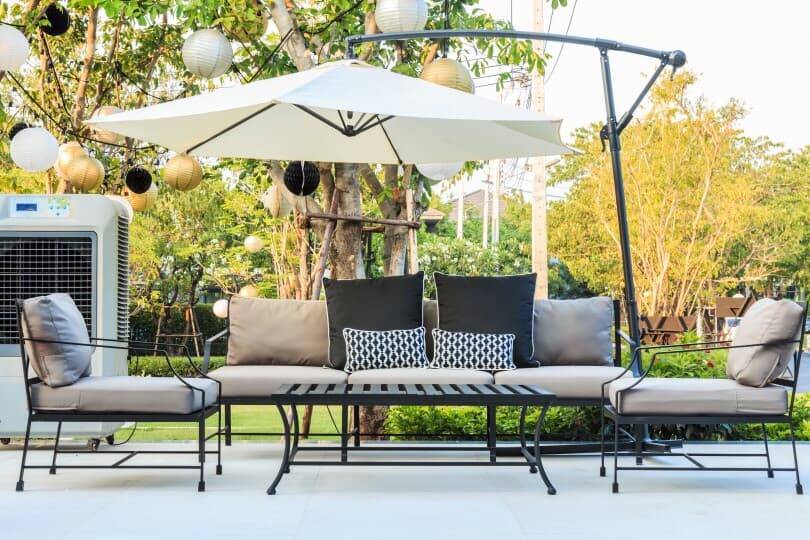
When it comes to keeping your patio umbrella from blowing away, one of the most important factors to consider is selecting the right base weight or material. A sturdy and heavy enough base can help ensure that your umbrella stays put, even in the strongest gusts of wind.
The weight or material of the base you need will depend on the size and design of your umbrella. For smaller umbrellas or lightweight cantilever umbrellas, a base with a weight of around 50 pounds should suffice. However, for larger umbrellas or those with a more complex design, a base with a higher weight capacity may be necessary.
When it comes to the material of the base, there are a few options to choose from. Plastic or resin bases are lightweight and easy to move, but they may not be as sturdy as metal or concrete bases. Metal bases can be heavy and durable, but they may also be more difficult to move around. Concrete bases are the most stable and can hold the most weight, but they are also the most difficult to move.
Another option is to look for a base with adjustable weight options, allowing you to add or remove weight as needed. Some bases also come with built-in weights, which can make them more convenient and easier to maneuver.
Ultimately, the most important thing is to choose a base that is appropriate for the size and design of your umbrella, and heavy enough to withstand the wind conditions in your area. By selecting the right base weight or material, you can help ensure that your patio umbrella stays securely in place, even on the windiest of days.

